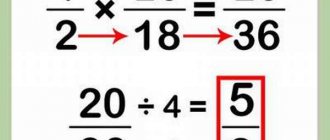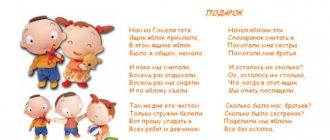Open lesson in Russian language 3rd grade (“Russian School”)
Komar Galina Alexandrovna
primary school teacher
MBOU Secondary School No. 1, Losino-Petrovsky, Moscow Region
Russian language lesson, 3rd grade, educational complex “School of Russia”
TOPIC: “Generalization of knowledge about nouns and adjectives”
Lesson type: repetition and consolidation of what has been learned (parts of speech).
Goals:
generalizing students' knowledge about parts of speech (noun, adjective, verb, preposition); development of intelligence, logical thinking; vocabulary enrichment; fostering a sense of mutual assistance.
Tasks:
Educational:
Teach literate, calligraphic writing.
Improve the ability to recognize parts of speech through natural phenomena and signs of spring.
Improve spelling vigilance, the ability to “see” spelling.
Educational:
Continue to develop students' oral speech.
Develop attention, thinking, speech, enrich and activate vocabulary.
Continue to work on developing the ability to compare, generalize, group, analyze; formulate your thoughts, express them out loud.
Develop the ability to work in pairs, in groups, develop control and self-control skills.
Develop interest in the Russian language, logical and figurative thinking, spelling vigilance, independence, intellectual and emotional sphere.
Develop memory and imagination.
Develop the skills to observe, compare, draw conclusions, and generalize.
To develop students’ independence in the classroom and interest in the learning process.
Educational:
To promote the education of a spiritually rich, creatively active personality.
To draw attention to the culture of Russian speech, to the word as a unit of communication between people.
Cultivate accuracy and independence.
Develop the ability to listen to classmates, express your point of view and justify it.
Cultivate pride in your knowledge and collectivism.
To develop the ability to collaborate when working in pairs.
Foster a sense of mutual assistance, mutual assistance, and responsibility for one’s actions.
Foster love for the Motherland.
Methods of work in the classroom - group work, conversation, individual and frontal questioning, independent work.
Teaching aids – tables, individual cards, educational board, tape recorder.
Forms of control – individual survey, independent work, frontal survey.
I. Organizational moment
(1 min)
Good morning, the day has begun,
First of all, we drive away laziness,
Don't yawn in class
And work and write!
“Now we looked at each other, smiled, took a deep breath, and exhaled. They sat down quietly. Let's start the lesson!
II. Communicate the topic and objectives of the lesson.
(1 min)
- Guys, a stranger came to our lesson. She encrypted her name in this riddle. You will remove all the voiceless unpaired consonants and then you will recognize the main character of our lesson.
Technological map of a fragment of a lesson in mathematics
TECHNOLOGICAL MAP OF A FRAGMENT OF A MATHEMATICS LESSON
Full name of the participant Daria Andreevna Ustinova
Lesson topic: “Dividing three-digit numbers by single-digit numbers”
Class: 3
The purpose of the lesson fragment is to create conditions for students to become familiar with the algorithm for dividing three-digit numbers by single-digit numbers and learn how to apply it in the lesson
Lesson fragment objectives:
Didactic: learn the written method of dividing a three-digit number by a single-digit number, determine the written method of dividing a multi-digit number by a single-digit number and justify your opinion; organize student planning activities together with the teacher to study or review a new topic, consolidate the skill of writing division of three-digit numbers into single-digit ones.
Developmental: find and read information presented in different ways (textbook, reference book, audio or video materials).
develop logical thinking, memory, mathematical knowledge and skills; accept and maintain the goal and learning task; cooperate with peers and teacher.
Educational: cultivate a positive attitude towards the subject “Mathematics”, participate in conversations, various activities, exercise mutual control and provide the necessary mutual assistance in cooperation; manifestation of motivation for educational and cognitive activity and the personal meaning of learning.
Characteristics of the lesson stages
| Lesson fragment stages | Educational objective of the lesson stage | Methods and techniques of work | Activity Teachers | Activity Students | Forms of organization of educational activities (frontal-F, individual-I, pair-P, group-G | Didactic tools, interactive equipment | Forms of control, mutual control and self-control | Planned results | ||
| Subject | Metasubject (cognitive, regulatory, communicative) | Personal | ||||||||
| Motivational stage | development at a personally significant level of internal readiness to fulfill the regulatory requirements of educational activities | Verbal (conversation), visual | Hello guys, let's check your readiness for the lesson. On the tables are a textbook, a lined notebook, and a pencil case. We sit straight, legs together. Guys, I have a rebus on the board, who knows what word is hidden here? True, but why do we need mathematics? | Checking readiness for the lesson. Greetings. Solving the puzzle Mathematics Express their opinions | F | Rebus on the board | Control | organize student planning activities together with the teacher to study or review a new topic. | find and read information presented in different ways; develop logical thinking, memory, mathematical knowledge and skills; accept and maintain the goal and learning task; cooperate with peers and teacher. | to cultivate a positive attitude towards the subject “Mathematics”, to participate in conversations, various types of activities, to demonstrate motivation for educational and cognitive activities and the personal meaning of learning. |
| The stage of updating knowledge on the proposed topic and carrying out the first trial action | preparing students’ thinking and organizing their awareness of the internal need for constructing educational actions and organizing the recording of individual difficulties in a trial action. | Verbal (conversation), visual | Okay, who can tell me how we divide a two-digit number by a single-digit number? (using the example located on the board). | Answer questions | F | Chalkboard with example | Control | organize student planning activities together with the teacher to study or review a new topic. | develop logical thinking, memory, mathematical knowledge and skills; accept and maintain the goal and learning task; cooperate with peers and teacher. | participate in conversations, demonstrate motivation for educational and cognitive activities and the personal meaning of learning. |
| Identifying difficulties: what is the complexity of the new material, what exactly creates the problem, searching for contradictions | Organizing an analysis by students of the situation that has arisen and, on this basis, identifying the places and causes of the difficulty is an awareness of what exactly is the insufficiency of their knowledge, skills or abilities. | Verbal (conversation) | That's right, what other numbers are there? And after two-digit ones, what numbers come next? What numbers can we divide three-digit numbers into? How is a three-digit number divided by a single-digit number? | Single-digit, two-digit, three-digit and multi-digit. Three-digit Single-digit, two-digit, three-digit Find it difficult to answer | F | Teacher's word | Control | organize student planning activities together with the teacher to study or review a new topic. | develop logical thinking, memory, mathematical knowledge and skills; accept and maintain the goal and learning task; cooperate with peers and teacher. | Participate in conversations, demonstrate motivation for educational and cognitive activities and the personal meaning of learning. |
| Development of a project, a plan to resolve their existing difficulties, consideration of many options, search for the optimal solution | setting goals for educational activities and, on this basis, choosing the method and means of their implementation. | Verbal (conversation) | What do you think is the topic of our lesson? What goal can we set? Let's make a lesson plan. | Dividing three-digit numbers by one-digit numbers. Learn to divide a three-digit number by a single-digit number, learn the division algorithm. Make a plan. | F | Presentation | Control | organize student planning activities together with the teacher to study or review a new topic. | develop logical thinking, memory, mathematical knowledge and skills; accept and maintain the goal and learning task; cooperate with peers and teacher. | participate in conversations, provide necessary mutual assistance in cooperation |
| Implementation of the chosen plan to resolve the difficulty. This is the main stage of the lesson, where the “discovery” of new knowledge occurs | the construction by students of a new method of action and the formation of the skills to apply it both when solving a problem that caused difficulty, and when solving problems of this class or type in general. | Verbal (conversation) Visual (demonstration) | Let's turn to the first point of the plan (learn the division algorithm). Find in the textbook on page 93 how you can divide a three-digit number by a single-digit number in writing. Let's look at it using the example of dividing the number 748 by 2 (on the board). First of all, we divide hundreds, there are only 7 hundreds. That is, we divide 7 by 2, the quotient will be 3, since 3 * 2 = 6, after that we subtract 6 from 7, we get 1 hundred, the next step is dividing tens, we For our 1 hundred we rewrite the number 4, that is, 4 tens, we get the number 14, we divide it by 2, write it as the quotient 7, then 7*2=14, divide 14 tens. Subtract 14 from 14, we get 0. There is no remainder. The units were all divided. What was the answer? We have implemented the first point of our plan. | Open the textbook and analyze the algorithm using the example presented on the blackboard. Answer: 374 | F | Blackboard | Control | organize student planning activities together with the teacher to study or review a new topic. | find and read information presented in different ways (textbook, reference book, audio or video materials). develop logical thinking, memory, mathematical knowledge and skills; accept and maintain the goal and learning task; cooperate with peers and teacher. | Participate in conversations, demonstrate motivation for educational and cognitive activities and the personal meaning of learning. |
| Primary consolidation of new knowledge. | students’ assimilation of a new method of action when solving standard problems | Verbal (explanation, conversation) Practical (exercise) | Now, open your notebooks and write down the date, great work, let's try to solve another example in pairs. I will give you worksheets, each pair will have their own task. We'll check it later. We have implemented the second point of the plan. | Do the task in pairs and then check the correct answer. 1 – 242 2-1 3-1 | P, F | Worksheets, document camera | Control, self-esteem, self-control, mutual control | determine the written method of dividing a multi-digit number into a single-digit number and justify your opinion; organize student planning activities together with the teacher to study or review a new topic. | find and read information presented in different ways (textbook, reference book, audio or video materials). develop logical thinking, memory, mathematical knowledge and skills; accept and maintain the goal and learning task; cooperate with peers and teacher. | participate in conversations, various activities, exercise mutual control and provide the necessary mutual assistance in cooperation; manifestation of motivation for educational and cognitive activity and the personal meaning of learning. |
| Independent work and standard testing | internalization of a new method of action and executive reflection (collective and individual) of achieving the goal of a trial educational action, application of new knowledge in standard tasks. | Verbal (explanation) Practical (exercise) | You complete the next task number 1 on page 93 yourself, solve it by talking to yourself. Then exchange notebooks and rate each other. | Complete the task independently according to the options. 214 Exchange notebooks and perform mutual checks and mutual assessments | AND | Textbook, workbooks | Control, mutual verification, mutual evaluation | determine the written method for dividing a multi-digit number into a single-digit number and justify your opinion. | find and read information presented in different ways (textbook, reference book, audio or video materials). develop logical thinking, memory, mathematical knowledge and skills; accept and maintain the goal and learning task; cooperate with peers and teacher. | participate in various activities, exercise mutual control and provide the necessary mutual assistance in cooperation. |
| Inclusion in the system of knowledge and skills | identifying the limits of applicability of new knowledge and teaching how to use it in a system of previously studied knowledge, repeating educational content necessary to ensure meaningful continuity, incorporating a new way of action into the knowledge system | Verbal (conversation) | So, let's review what we learned in class today? What do we share first in the example on the board? | On dividing three-digit numbers by one-digit numbers. | F | Blackboard | Control | organize student planning activities together with the teacher to study or review a new topic. | develop logical thinking, memory, mathematical knowledge and skills; accept and maintain the goal and learning task; cooperate with peers and teacher. | participate in the conversation, demonstrate motivation for educational and cognitive activity and the personal meaning of learning. |
| Reflection, which includes reflection on educational activities, introspection, and reflection on feelings and emotions | students’ self-assessment of the results of their educational activities, awareness of the method of construction and the boundaries of application of a new method of action. | Verbal (conversation) | Let's see if we have implemented all the points in the plan? What was our goal? Have we achieved it? Rate yourself according to the criteria on the board I would like to give 5 today... because she...(look at the situation) Dz. page 93, number 3. | Yes all. Yes Express their point of view. | F, I | Presentation | Control, self-esteem | organize student planning activities together with the teacher to study or review a new topic. | develop logical thinking, memory, mathematical knowledge and skills; accept and maintain the goal and learning task; cooperate with peers and teacher. | participate in the conversation, demonstrate motivation for educational and cognitive activity and the personal meaning of learning. |







